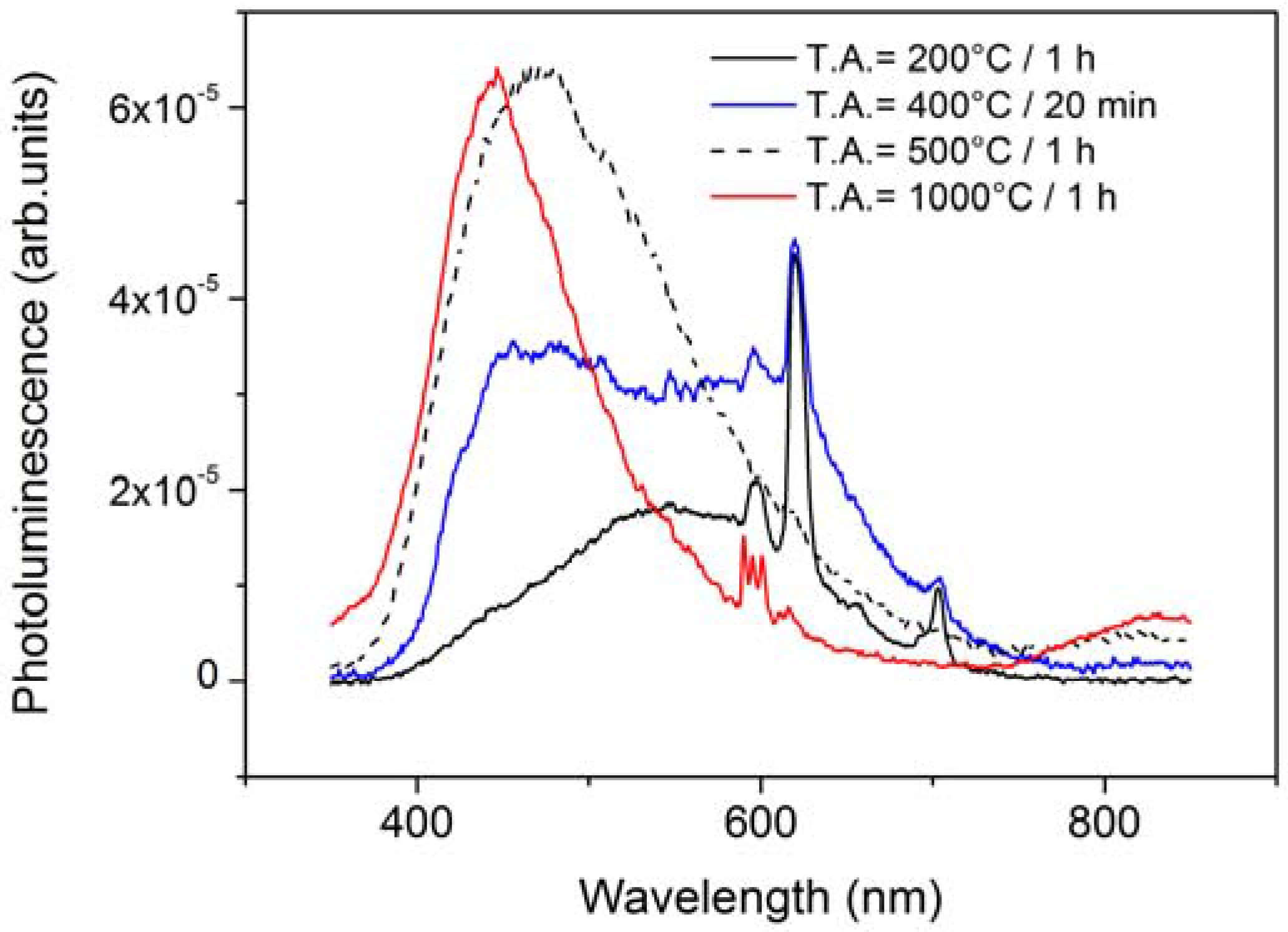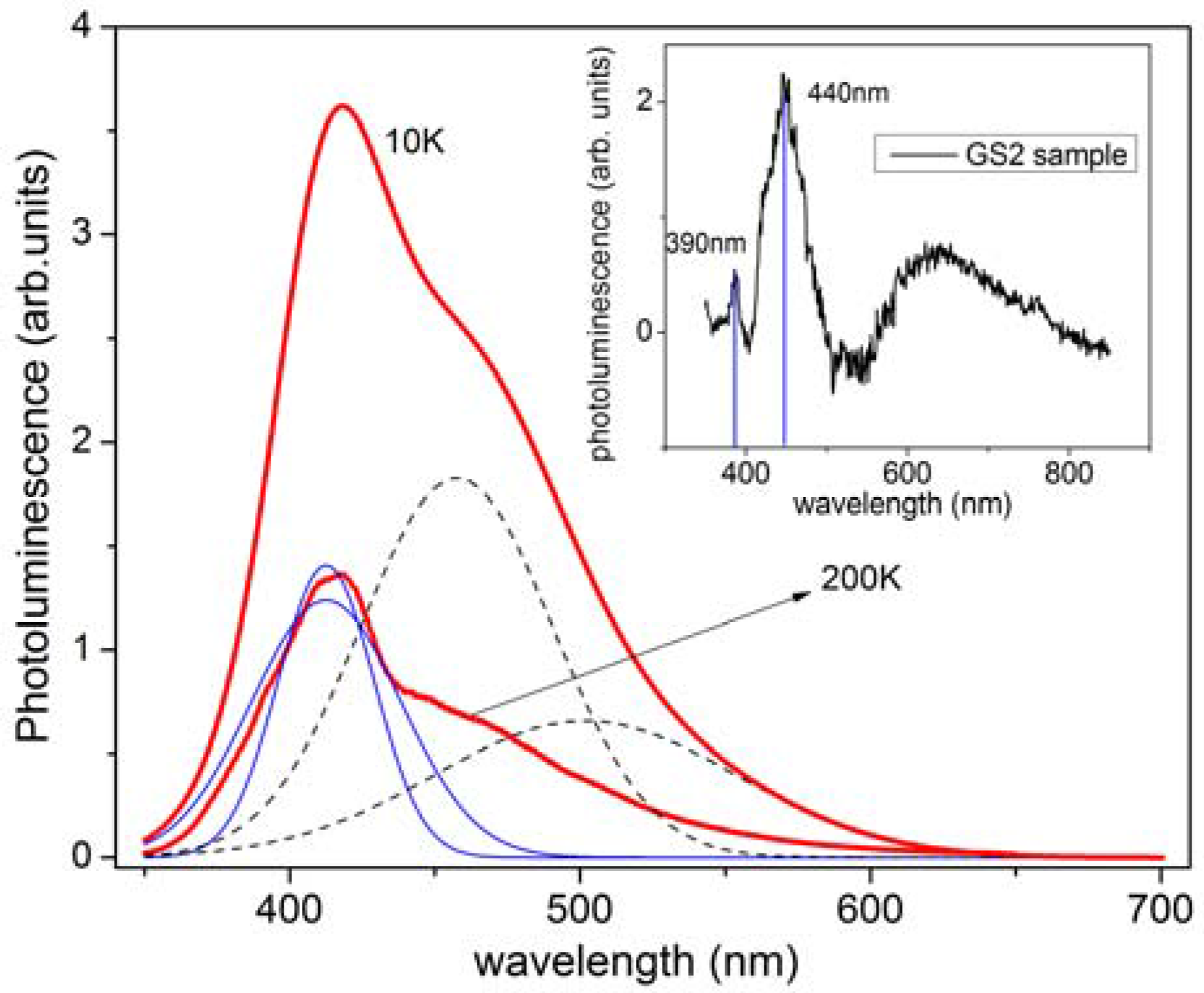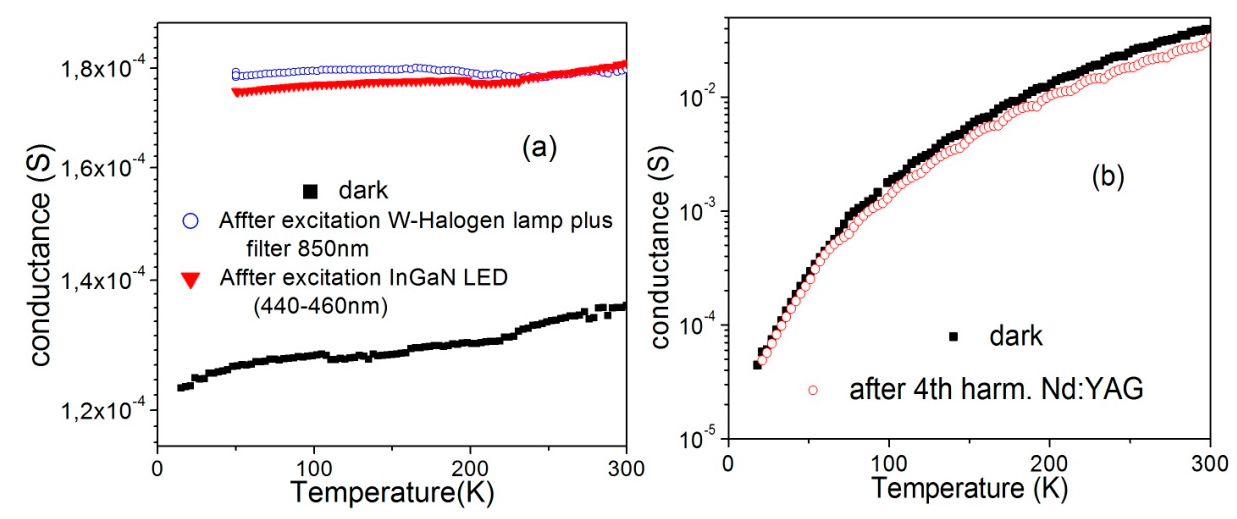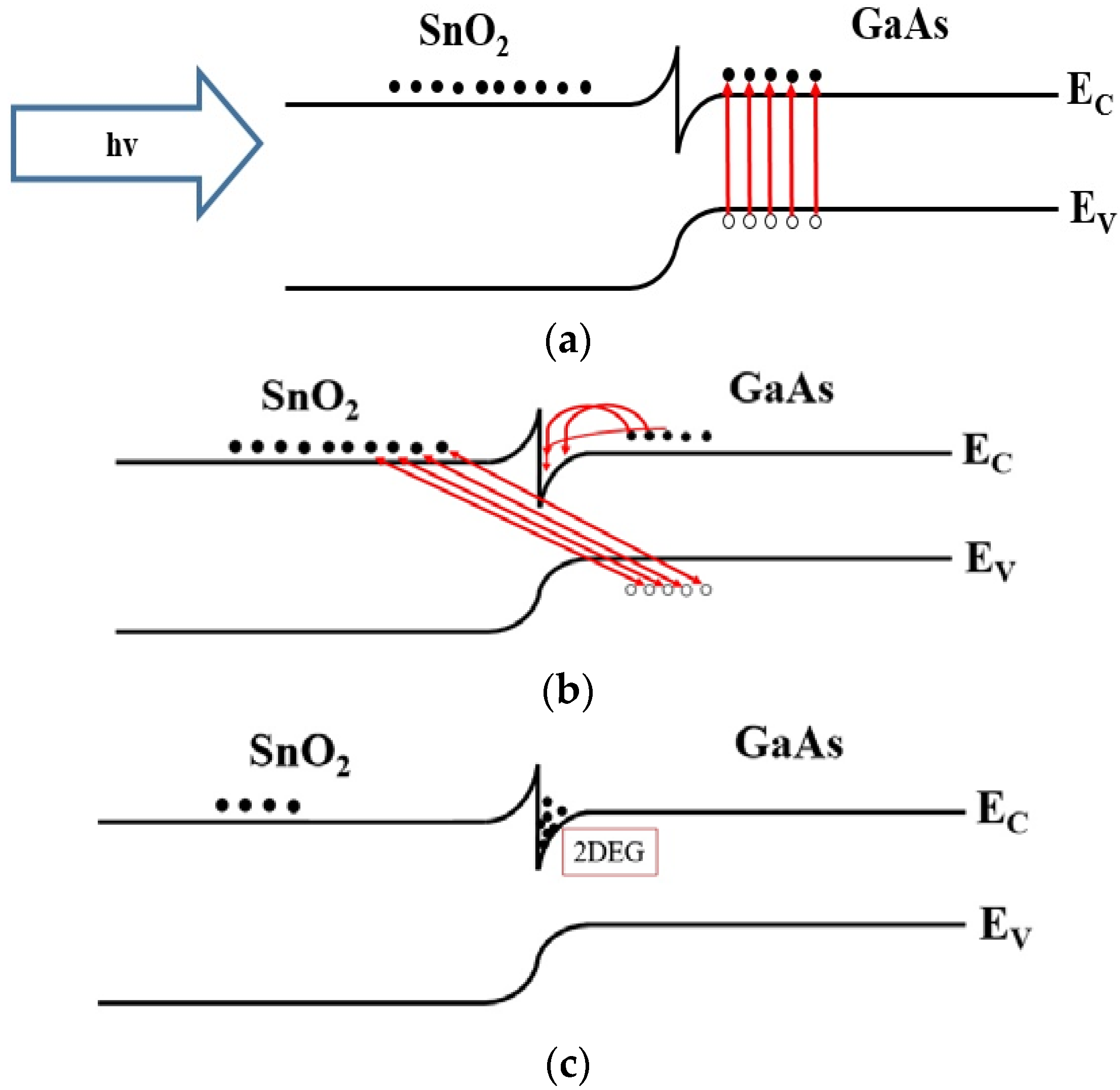Photoluminescence of Rare-Earth Ions in the Nanocrystalline GaAs/SnO2 Heterostructure and the Photoinduced Electrical Properties Related to the Interface
Abstract
:1. Introduction
2. Results
2.1. Photoluminescence Results
2.2. Electrical Characterization
3. Discussion
3.1. Optical Emission Properties
3.2. Electrical Transport Properties
4. Materials and Methods
4.1. Synthesis of Heterostructure
4.2. Electrical and Optical Characterization
5. Conclusions
Supplementary Materials
Supplementary File 1Supplementary File 2Supplementary File 3Supplementary File 4Acknowledgments
Author Contributions
Conflicts of Interest
References
- Ray, S.C.; Karanjai, M.K.; Dasgupta, D. Tin dioxide based transparent semiconducting films deposited by the dip-coating technique. Surf. Coat. Technol. 1998, 102, 73–80. [Google Scholar] [CrossRef]
- Ishii, M.; Komuro, S.; Morikawa, T. Study on atomic coordination around Er doped into anatase- and rutile- TiO2: Er-O clustering dependent on the host crystal phase. J. Appl. Phys. 2003, 94, 3823–3827. [Google Scholar] [CrossRef]
- Peng, H.; Song, H.; Chen, B.; Wang, J.; Lu, S.; Kong, X.; Zhang, J. Temperature dependence of luminescent spectra and dynamics in nanocrystalline Y2O3: Eu3+. J. Chem. Phys. 2003, 118, 3277–3282. [Google Scholar] [CrossRef]
- Yang, X.; Jurkovic, M.J.; Heroux, J.B.; Wang, W.I. Molecular beam epitaxial growth of InGaAsN: Sb/GaAs quantum wells for long-wavelength semiconductor lasers. Appl. Phys. Lett. 1999, 75, 178–180. [Google Scholar] [CrossRef]
- Sze, S.M. Physics of Semiconductor Devices; John Wiley & Sons: New York, NY, USA, 1985. [Google Scholar]
- Yu, L.; Song, H.; Lu, S.; Liu, Z.; Yang, L.; Wang, T.; Kong, X. Thermal quenching characteristics in LaPO4:Eu nanoparticles and nanowires. Mater. Res. Bull. 2004, 39, 2083–2088. [Google Scholar] [CrossRef]
- Morais, E.A.; Scalvi, L.V.A.; Tabata, A.; De Oliveira, J.B.B.; Ribeiro, S.J.L. Photoluminescence of Eu3+ ion in SnO2 obtained by sol–gel. J. Mater. Sci. 2008, 43, 345–349. [Google Scholar] [CrossRef]
- Dorenbos, P. 5d-level energies of Ce3+ and the crystalline environment. III. Oxides containing ionic complexes. Phys. Rev. B Condens. Matter Mater. Phys. 2001, 64, 125117. [Google Scholar] [CrossRef]
- Annapurna, K.; Dwivedi, R.N.; Kundu, P.; Buddhudu, S. Blue Emission spectrum of Ce3+: ZnO-B2O3-SiO2 optical glass. Mater. Lett. 2004, 58, 787–789. [Google Scholar] [CrossRef]
- Mao, Z.; Zhu, Y.; Wang, Y.; Gan, L. Ca2SiO4: Ln (Ln5 Ce3+, Eu2+, Sm3+) tricolor emission phosphors and their application for near-UV white light-emitting diode. J. Mater. Sci. 2014, 49, 4439–4444. [Google Scholar] [CrossRef]
- Zhang, H.; Fu, X.; Niu, S.; Sun, G.; Xin, Q. Luminescence properties of Li+ doped nanosized SnO2:Eu. J. Lumin. 2005, 115, 7–12. [Google Scholar] [CrossRef]
- Gu, F.; Wang, S.F.; Lu, M.K.; Qi, Y.X.; Zhou, G.J.; Xu, D.; Yuan, D.R. Luminescent characteristics of Eu3+ in SnO2 nanoparticles. Opt. Mater. 2004, 25, 59–64. [Google Scholar] [CrossRef]
- Pineiz, T.F.; Morais, E.A.; Scalvi, L.V.A.; Bueno, C.F. Interface formation of nanostructured heterojunction SnO2: Eu/GaAs and electronic transport properties. Appl. Surf. Sci. 2013, 267, 200–205. [Google Scholar] [CrossRef]
- Bueno, C.F.; Scalvi, L.V.A.; Li, M.S.; Saeki, M.J. Luminescence of Eu3+ in the thin film heterojunction GaAs/SnO2. Opt. Mater. Express 2015, 5, 59–72. [Google Scholar] [CrossRef]
- Tan, S.T.; Zhao, J.; Iwan, S.; Su, X.W.; Tang, X.; Ye, J.; Bosman, M.; Tang, L.J.; Lo, G.-Q.; Teo, K.L. n-ZnO/n-GaAs heterostructured white light-emitting diode: Nanoscale analysis and electroluminescence studies. IEEE Trans. Electron. Devices 2010, 57, 129–133. [Google Scholar] [CrossRef]
- Cuculescu, E.; Evtodiev, I.; Caraman, M. Non-equilibrium charge carriers generation—Recombination mechanisms at the interface of the SnO2/GaSe heterojunction. Thin Solid Films 2009, 517, 2515–2518. [Google Scholar] [CrossRef]
- Vatavu, S.; Zhao, H.; Caraman, I.; Gasin, P.; Ferekides, C. Photoluminescence studies of CdTe/SnO2 and CdTe/CdS heterojunctions: The influence of oxygen and the CdCl2 heat treatment. Thin Solid Films 2011, 519, 7176–7179. [Google Scholar] [CrossRef]
- Maciel, J.L.B., Jr.; Floriano, E.A.; Scalvi, L.V.A.; Ravaro, L.P. Growth of Al2O3 thin film by oxidation of resistively evaporated Al on top of SnO2, and electrical properties of the heterojunction SnO2/Al2O3. J. Mater. Sci. 2011, 46, 6627–6632. [Google Scholar] [CrossRef]
- Wang, E.Y.; Legge, R.N. General properties of SnO2-GaAs and SnO2-Ge heterojunction photovoltaic cells. IEEE Trans. Electron. Devices 1978, 25, 800–803. [Google Scholar] [CrossRef]
- Bark, C.W.; Sharma, P.; Wang, Y.; Beak, S.H.; Lee, S.; Ryu, S. Switchable Induced Polarization in LaAlO3/SrTiO3 Heterostructures. Nano Lett. 2012, 12, 1765–1771. [Google Scholar] [CrossRef]
- Bian, L.; Du, F.; Yang, S.; Ren, Q.; Liu, Q.L. Crystal structure and near-ultraviolet photoluminescence properties of Ba9Sc2Si6O24: Ce3+,Na. J. Lumin. 2013, 137, 168–172. [Google Scholar] [CrossRef]
- Fang, Z.; Cao, R.; Zhang, F.; Ma, Z.; Dong, G.; Qiu, J. Efficient spectral conversion from visible to near-infrared in transparent glass ceramics containing Ce3+–Yb3+ codoped Y3Al5O12 nanocrystals. J. Mater. Chem. C 2014, 2, 2204–2211. [Google Scholar] [CrossRef]
- Inpasalini, M.S.; Singh, A.; Mukherjee, S. Luminescence and magnetism studies of strongly quantum confined SnO2 dots. J. Mater. Sci.: Mater. Electron. 2016, 27, 4392–4398. [Google Scholar] [CrossRef]
- Ko, S.L.; Park, S.; Kim, C.-W.; Lee, D.; Choi, M.S.; Lee, C.; Jin, C. Shape-selective synthesis and photoluminescence of SnO2 nanostructures under different catalyst conditions. Appl. Phys. A 2015, 121, 715–721. [Google Scholar] [CrossRef]
- Sánchez Zeferino, R.; Pal, U.; Meléndrez, R.; Barboza Flores, M.; Barboza, M. PL and TL behaviors of Ag-doped SnO2 nanoparticles: Effects of thermal annealing and Ag concentration. Adv. Nano Res. 2013, 1, 193–202. [Google Scholar] [CrossRef]
- Azevedo, G.D.; Silva, J.H.D.; Avendano, E. Effect of hydrogenation on the optical and structural properties of GaAs thin films prepared by rf-magnetron sputtering. Nucl. Instrum. Mehods Phys. Res. Sect. B-Beam Interact. Mater. Atoms 2005, 238, 329–333. [Google Scholar] [CrossRef]
- Acun, A.; Akaishi, A.; Angot, T.; Araidai, M.; Aristov, V.; Aruga, T.; Avdeev, M.; Banas, K.; Banas, A.; Banhart, F.; et al. Atomically Controlled Surfaces Interfaces and Nanostructures; Bianconi, A., Marcelli, A., Eds.; Superstripes Press: Rome, Italy, 2016. [Google Scholar]




© 2017 by the authors; licensee MDPI, Basel, Switzerland. This article is an open access article distributed under the terms and conditions of the Creative Commons Attribution (CC BY) license ( http://creativecommons.org/licenses/by/4.0/).
Share and Cite
Machado, D.H.O.; Scalvi, L.V.A.; Bueno, C.F. Photoluminescence of Rare-Earth Ions in the Nanocrystalline GaAs/SnO2 Heterostructure and the Photoinduced Electrical Properties Related to the Interface. Condens. Matter 2017, 2, 9. https://doi.org/10.3390/condmat2010009
Machado DHO, Scalvi LVA, Bueno CF. Photoluminescence of Rare-Earth Ions in the Nanocrystalline GaAs/SnO2 Heterostructure and the Photoinduced Electrical Properties Related to the Interface. Condensed Matter. 2017; 2(1):9. https://doi.org/10.3390/condmat2010009
Chicago/Turabian StyleMachado, Diego H. O., Luis V. A. Scalvi, and Cristina F. Bueno. 2017. "Photoluminescence of Rare-Earth Ions in the Nanocrystalline GaAs/SnO2 Heterostructure and the Photoinduced Electrical Properties Related to the Interface" Condensed Matter 2, no. 1: 9. https://doi.org/10.3390/condmat2010009
APA StyleMachado, D. H. O., Scalvi, L. V. A., & Bueno, C. F. (2017). Photoluminescence of Rare-Earth Ions in the Nanocrystalline GaAs/SnO2 Heterostructure and the Photoinduced Electrical Properties Related to the Interface. Condensed Matter, 2(1), 9. https://doi.org/10.3390/condmat2010009




